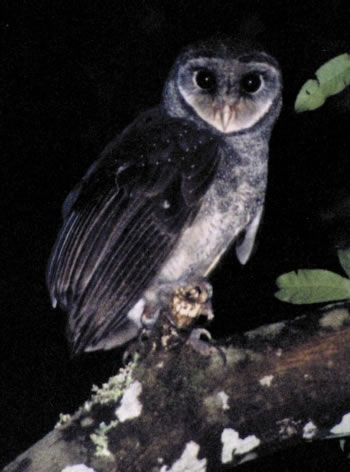|
| 질의: Small white | 결과: 855번째/2237 | |
Greater Sooty Owl (Tyto tenebricosa) - Wiki
| 제목: | Greater Sooty Owl (Tyto tenebricosa) - Wiki
| |

| 해상도: 350x472
파일크기: 30129 Bytes
등록시간: 2007:11:17 13:52:27
|
Greater Sooty Owl
From Wikipedia, the free encyclopedia
Order: Strigiformes
Family: Tytonidae
[Photo] Greater Sooty Owl (Tyto tenebricosa). Image: ?? Russell Jago. Source: NSW Threatened Species - Sooty Owl
The Greater Sooty Owl (Tyto tenebricosa) is a medium to large owl found in south-eastern Australia, Montane rainforests of New Guinea and have been seen on Flinders Island in the Bass Strait. They have a finely white spotted head with scattered white spots on the wings. The females are lighter colored than the males. The females length is 37-43 cm and weighs 750-1000 gm. The male is smaller and length is 37-43 cm and weighs 500-700 gm. The wing length is 30-40 cm. The large dark eyes are set in a round large facial disk. The facial disk is dark gray silver or sooty black and has a heavy black edge. The upper part of the owl is black to dark gray and the under part is lighter. Their call is a piercing shriek which can last up to two seconds. The tail is short and the legs are feathered large black talons. They are nocturnal and hide in hollow tree trunks, caves and in tall trees with heavy foliage.
Habitat
They are nocturnal and hide in hollow tree trunks, caves and in tall trees with heavy foliage during daylight hours. Rarely seen or heard they are territorial and can be found in areas with deep gullies in eucalyptus forests, where smooth-barked gum trees, tree ferns and tropical fruit trees are present. They hunt in drier areas but roost and breed in the moister areas. They feed on birds, sugar gliders and other small mammals. They are silent except during mating season when the gives high pitched shrieks to attract the female. Greater Sooty owls are territorial and remain in the same area throughout their lives.
Reproduction
The nest is in a large hollow tree or a cave. The female remains in the nest for several weeks before she lays one or two dull white eggs from January through June. The incubation time is 42 days. The males brings food to the female who rarely leaves the nest. The young are born with dull grey down and can fly in three months. They are totally dependent on the parents for up to thirty days. Their lifespan is unknown. They are Territorial and sedentary throughout the year.
Conservation status
International
Their status is not globally threatened.
Australia
Greater Sooty Owls are not listed as threatened on the Australian Environment Protection and Biodiversity Conservation Act 1999. However, their conservation status varies from state to state within Australia. For example:
The Sooty Owl is listed as threatened on the Victorian Flora and Fauna Guarantee Act (1988). Under this Act, an Action Statement for the recovery and future management of this species has been prepared.
On the 2007 advisory list of threatened vertebrate fauna in Victoria, the Greater Sooty Owl is listed as vulnerable.
http://en.wikipedia.org/wiki/Greater_Sooty_Owl
| The text in this page is based on the copyrighted Wikipedia article shown in above URL. It is used under the GNU Free Documentation License. You may redistribute it, verbatim or modified, providing that you comply with the terms of the GFDL. |
^o^
동물그림창고 똑똑전화 누리집
^o^
|
|
|